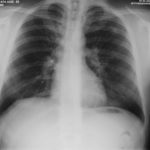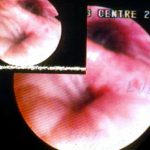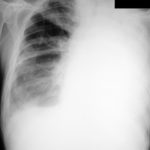Date: 26 November 2013
Copyright: n/a
Notes:
Professor
Department of Medical Microbiology
University of Wisconsin
My research focus lies in genetically dissecting those aspects of Aspergillus spp. that render them potent pathogens and superb natural product machines. My laboratory’s research includes elucidation of fungal sporulation and host/pathogen interactions; processes intimately linked to secondary metabolite (e.g. mycotoxin) production. My tactic has been to use the genetic model Aspergillus nidulans to elucidate important biological processes in this genus and then carry this information to the plant pathogens A. flavus and A. parasiticus and the human pathogen A. fumigatus. The former two pathogens contaminate seed crops worldwide with aflatoxin, the most potent naturally occurring carcinogen known. The latter pathogen is now tied with Candida as the most serious human mycopathogen in developed countries where it can cause invasive aspergillosis, a disease with a mortality rate ranging from 50 to 90%.
Areas of fungal biology that my lab has been central in developing include:
I. Genetic Regulation of Secondary Metabolism and the Role of Toxic Metabolites in Fungal Virulence.
- Bok J.-W, Balajee S A, Marr K A, Andes D, Fog Nielsen K. Frisvad J C. Keller N P (2005) LaeA, a regulator of morphogenetic fungal virulence factors. Euk Cell 4:1574-1582.
- Perrin RM, Fedorova ND, Bok JW, Cramer RA, Wortman JR, Kim HS, Nierman WC, Keller NP. (2007) Transcriptional regulation of chemical diversity in Aspergillus fumigatus by LaeA. PloS Pathogens Apr;3(4):e50.
- Shwab E., Bok JW, Tribus M, Galehr J, Graessle S, Keller NP. (2007) Histone deacetylase activity regulates chemical diversity in Aspergillus. Euk Cell 6:1656-64
II. Gene silencing processes.
- Hammond T M, Bok J-W, Andrewski MD, Reyes-Domínguez Y, Scazzocchio C, Keller NP. (2008) RNA silencing gene truncation in the filamentous fungus Aspergillus nidulans. Euk Cell Dec 7(2):339-49
- Hammond T M, Andrewski MD, Roossinck M, Keller NP. (2008) Aspergillus mycoviruses are targets and suppressors of RNA silencing. Euk Cell 2007 7(2):350-7
- Bok JW, Noordermeer D, Kale S P, Keller NP (2006) Secondary metabolic gene cluster silencing in Aspergillus nidulans. Mol Microbiol 61:1636-1645
III. Host/fungal signaling.
- Tsitsigiannis D I, Bok J-W, Andes D, Fog Nielsen K, Frisvad J C, Keller N P (2005) Aspergillus cyclooxygenase-like enzymes are associated with prostaglandin production and virulence. Infect Immun: 73:4548-4559.
- Brodhagen M, Tsitsigiannis D, Hornung E, Goebel C, Feussner I, Keller NP. (2008) Reciprocal oxylipin-mediated cross talk in the Aspergillus/seed pathosystem. Mol Microbiol 67:378-391
Contact details:
Nancy Keller
Professor
3476 Microbial Science Building
Department Medical Microbiology and Immunology
Department of Plant Pathology
UW-Madison
1550 Linden Dr., Madison, WI 53706
phone (608) 262-9795
fax (608) 262-8418
npk@plantpath.wisc.edu
Images library
-
Title
Legend
-
A. Necrotic mass prolapsing in and out of the distal right intermediate bronchus obscuring both the basal stem and basal division
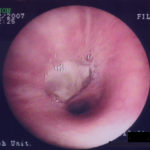
-
History : A 20 yr old female with cystic fibrosis complicated by CF-related Diabetes mellitus (diagnosed at age 12 years) & ABPA (diagnosed at
15 years ). She was fairly stable until last 9 months, when she started to experience frequent pulmonary exacerbations, which have prompted intensive therapies.
Her serum IgE at the time of diagnosis was 5060 IU/L, skin prick test for aspergillus was positive, and serum was positive for precipitating antibodies to Aspergillus. She was treated with oral prednisone (1 mg/kg/day) for first two weeks followed by prednisone at 0.5 mg/kg every other day for at least 6 months with some clinical and serologic improvement. Over the following 5 years, she presented with a pattern of repeated episodic exacerbations with wheezing and crackles, increases in IgE and need to increase prednisone dosage. In an attempt to control her frequent ABPA relapses, itraconazole was added at 200mg twice a day, with some clinical & serologic improvement.
2-3 weeks prior to the scans and X rays, she developed severe protracted coughing spells associated with minor hemoptysis, low grade intermittent fever, and weight loss. Her FEV1 declined in a 3 months period from 56% to 33%.
A chest-x ray (Fig 3) did not reveal any new changes when compared to the one obtained almost a year before. A CT scan of the chest Figs 1 and 2- lateral view), however shows an ovoid soft tissue density within an ectatic bronchi in the anterior basal segment of the LLL, felt to be an aspergilloma.She was started on oral voriconazole (3 months after the above scans and X-rays) which is better absorbed in CF patients than itraconazole, at 200mg twice a day. Her prednisone was gradually reduced to 5 mgs/day and her FEV1 increased to 46% of predicted (03/31/10), her IgE level was 1167 kU/L (previously in January 2009, her IgE level was 3053 kU/L)and her weight has plateaued.
Since she was not fit enough for surgery at that time, removing the aspergilloma by flexible bronchoscopy was unsuccessful. The aspergilloma can be seen at bronchoscopy in Fig 4. ,
, 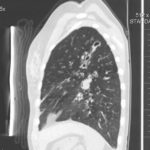 ,
, 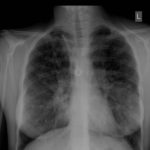 ,
, 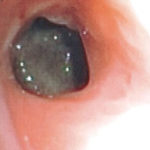
-
Widespread mucoid impaction also seen, particularly in left side, suggestive of allergic bronchopulmonary aspergillosis.
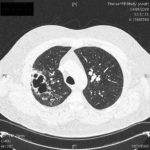
-
Microscopy of fungal hyphae isolated from fungal culture (lactophenol blue)

-
A CT scan performed at this time showed an enhancing lesion with ill defined margins involving the pterigopalatine fossa, the maxillary antrum , orbital apex and middle cranial fossa. There was also destruction of boney architecture locally.
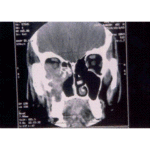
-
The patient underwent a pneumonectomy because of the severity of her disease process, and uncertainty about the diagnosis, prior to serology results being obtained.
Serology showed an IgE of 2600, with a strongly positive Aspergillus RAST test and weakly positive Aspergillus precipitins. Material removed at bronchoscopy showed eosinophilia. These features confirm a diagnosis of allergic bronchopulmonary aspergillosis (ABPA).
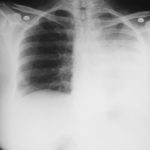 ,
, 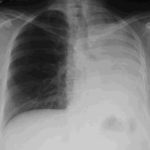 ,
, 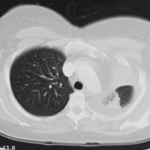 ,
,  ,
,  ,
, 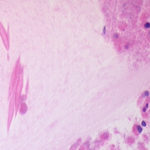 ,
, 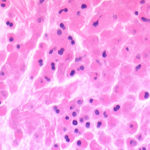 ,
,  ,
,  ,
, 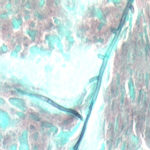


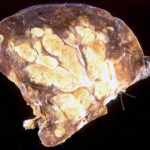
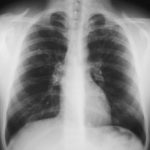 ,
, 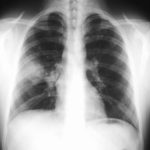 ,
, 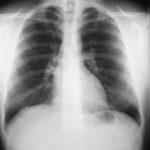 ,
,  ,
, 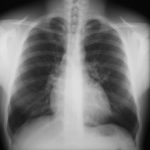 ,
, 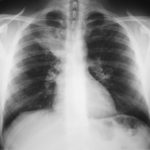 ,
, 